Uno /ˈu.no/. 1. The Italian and Spanish word for the number ‘one.’ 2. A card game that can invoke such fury in a player that they throw their hand of cards across the room.
Now, this has never happened to me during a game of Uno, but I may have witnessed this level of frustration on at least one occasion.
So, what is it about Uno that brings out the worst in any respectable gamer? And what even is the proper way to play? All these questions and more will be answered in our Uno review.
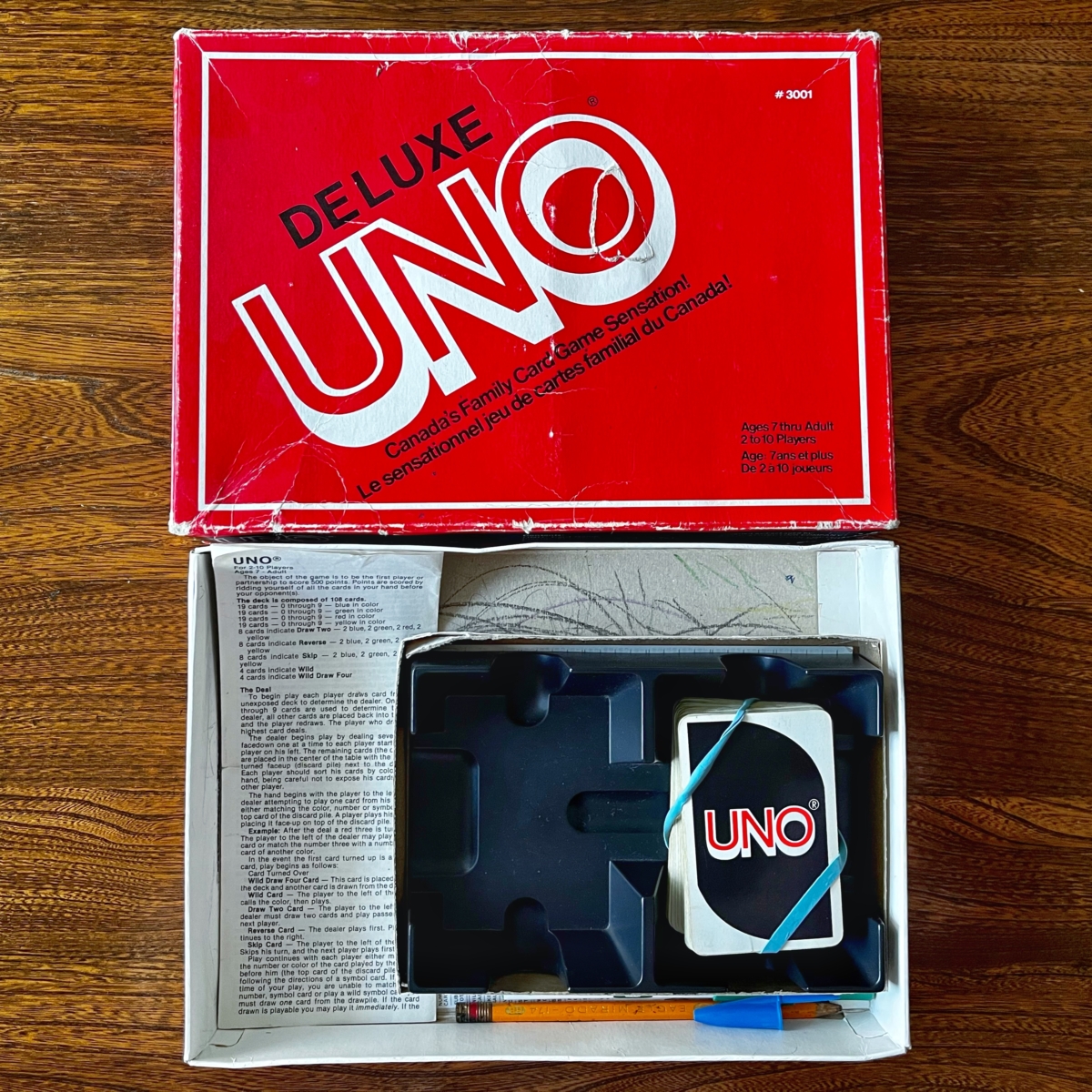
My inherited copy of Uno from the 1970s. Apparently, the “deluxe” game treatment back then consisted of box air and a card tray.
Contents
Uno Gameplay Overview
Uno is a card game for 2 to 10 players in which you try to be the first player to score 500 points. (If this is brand new information to you, congratulations on having successfully avoidedUno for the past five decades.)
Each round, players will play out cards from their hand until one person has played all their cards (or ‘goes out’). Then, points are scored from the cards in each other players’ hand and awarded to the player who went out.
If they now have at least 500 points, they win. Otherwise, all cards are shuffled, and a new round begins.
Uno Cards
Uno’s deck is comprised of 108 cards: two-thirds of which are cards numbered 0 through 9 divided evenly amongst four colors (red, blue, green, and yellow).
The rest of the deck is made up of special action cards that alter the gameplay in some meaningful way.
The five types of special cards are:
- Draw Two: the next player in turn order draws two cards and forfeits their turn.
- Skip: the next player’s turn is skipped.
- Reverse: change the direction of play. (In a 2-player game, this acts like a Skip card.)
- Wild: the player gets to choose the color of the next card to be played. (They may change it to a new color or continue to play with the same color as before.)
- Wild Draw Four: like the Wild, the player chooses the color to be played. The next player in turn order also draws four cards. (Note: this card can only be played when a player can’t match the current color.)
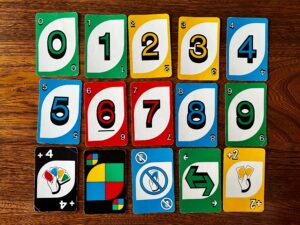
The different types of cards you’ll find in an Uno deck. The special cards on the bottom row, from left to right, are: Wild Draw Four, Wild, Draw Two, Reverse, Skip.
How To Play Uno
To begin, the cards are shuffled, and a hand of seven cards is dealt facedown to each player. The remaining cards form the draw pile for the game.
Next, flip the top card of the draw pile faceup beside it. This card is the start of the discard pile, where players will play cards from their hand.
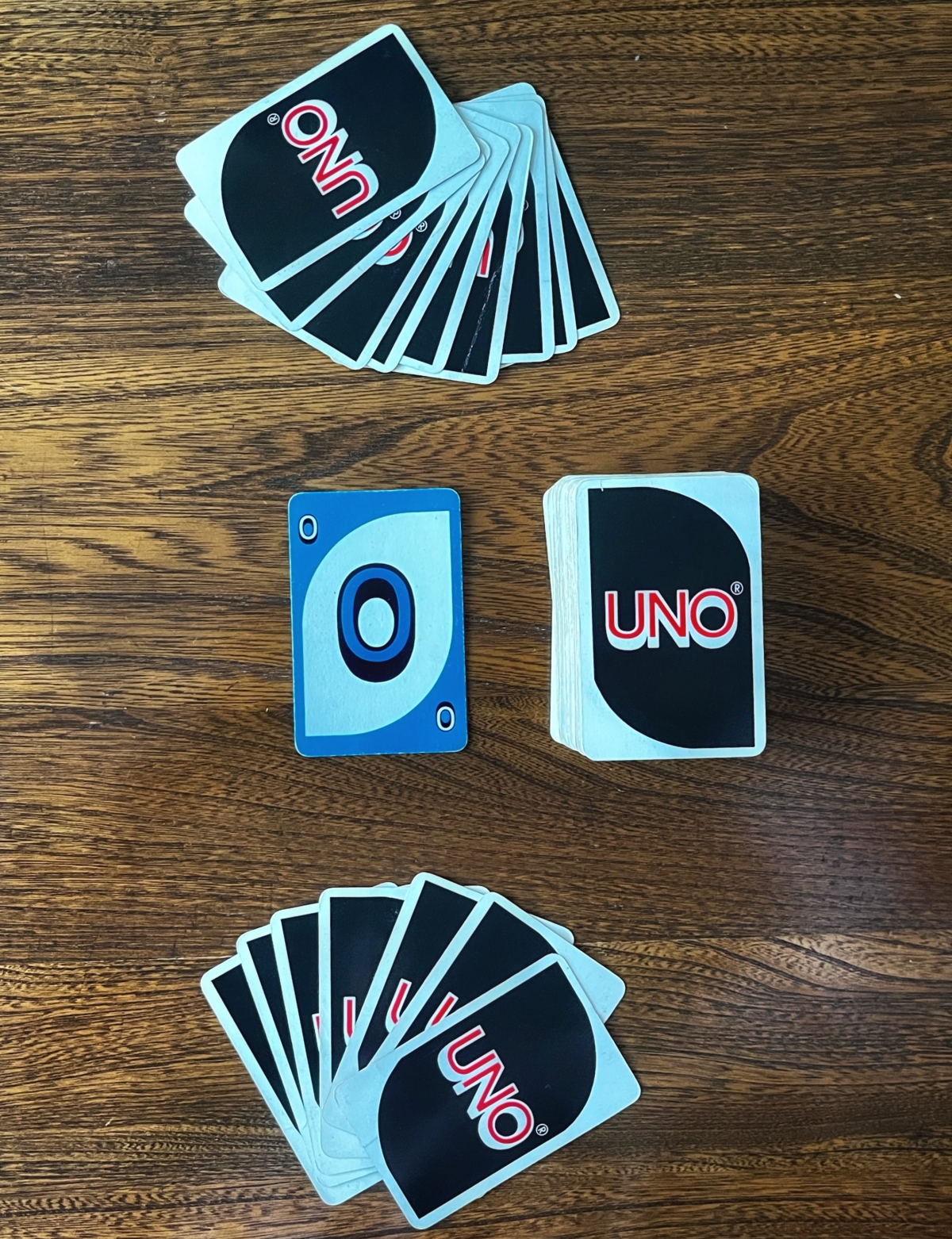
A game of Uno set up for 2 players. (The card backs in modern editions are red and more vibrant.)
A Player Turn in Uno
The player to the left (clockwise) of the player who dealt now attempts to play a card from their hand. To do so, they must match:
- the color,
- the number, or
- the symbol of the top card of the discard pile.
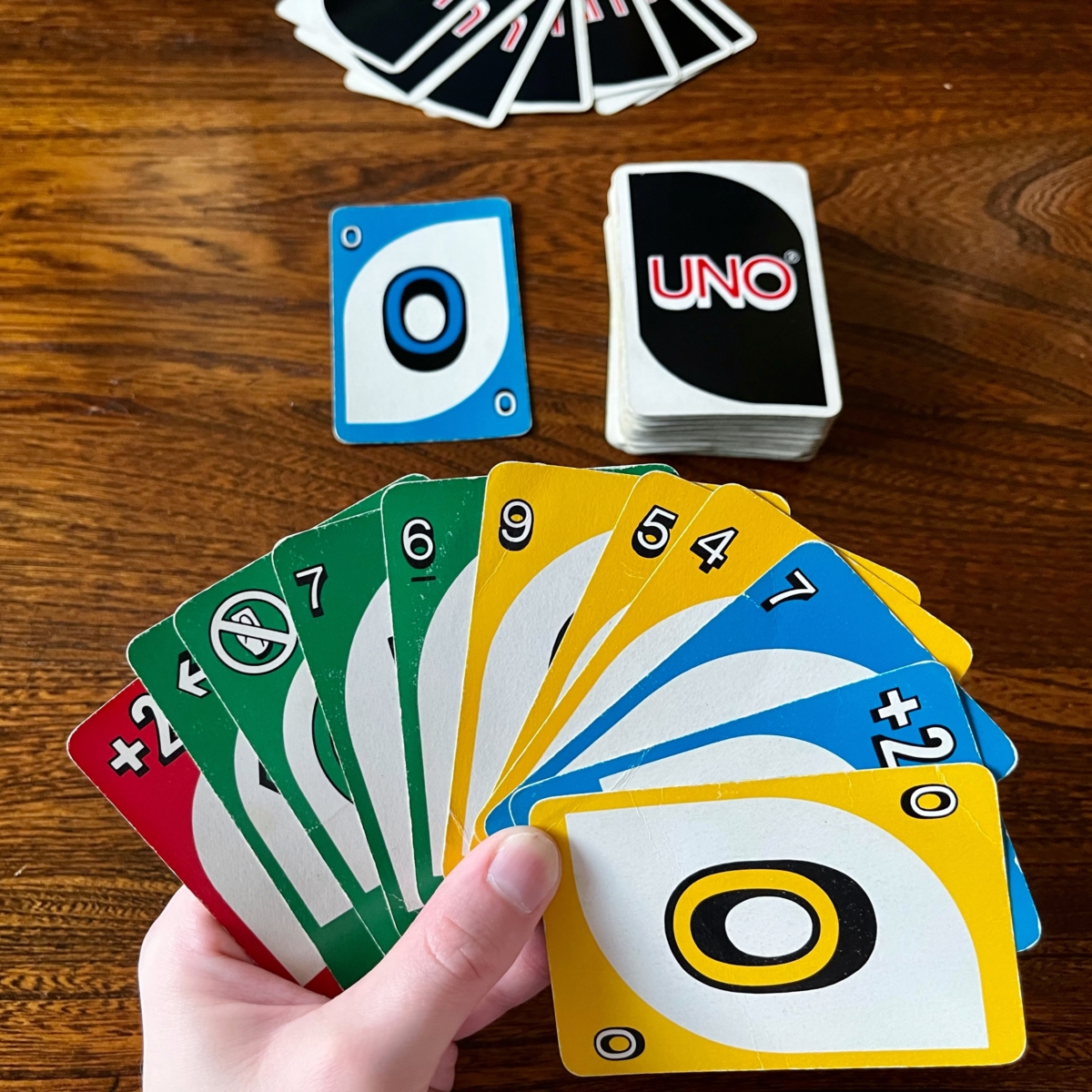
This player can choose to play their yellow 0, their blue Draw Two, or their blue 7.
Wild cards, however, do not need a match to be played; you are allowed to play Wild cards as freely as you’d like (although you’ll probably want to save them for those times when you’re stuck).
Wild Draw Four cards, however, have a slight restriction: you may only play one if you cannot match the color of the top card.
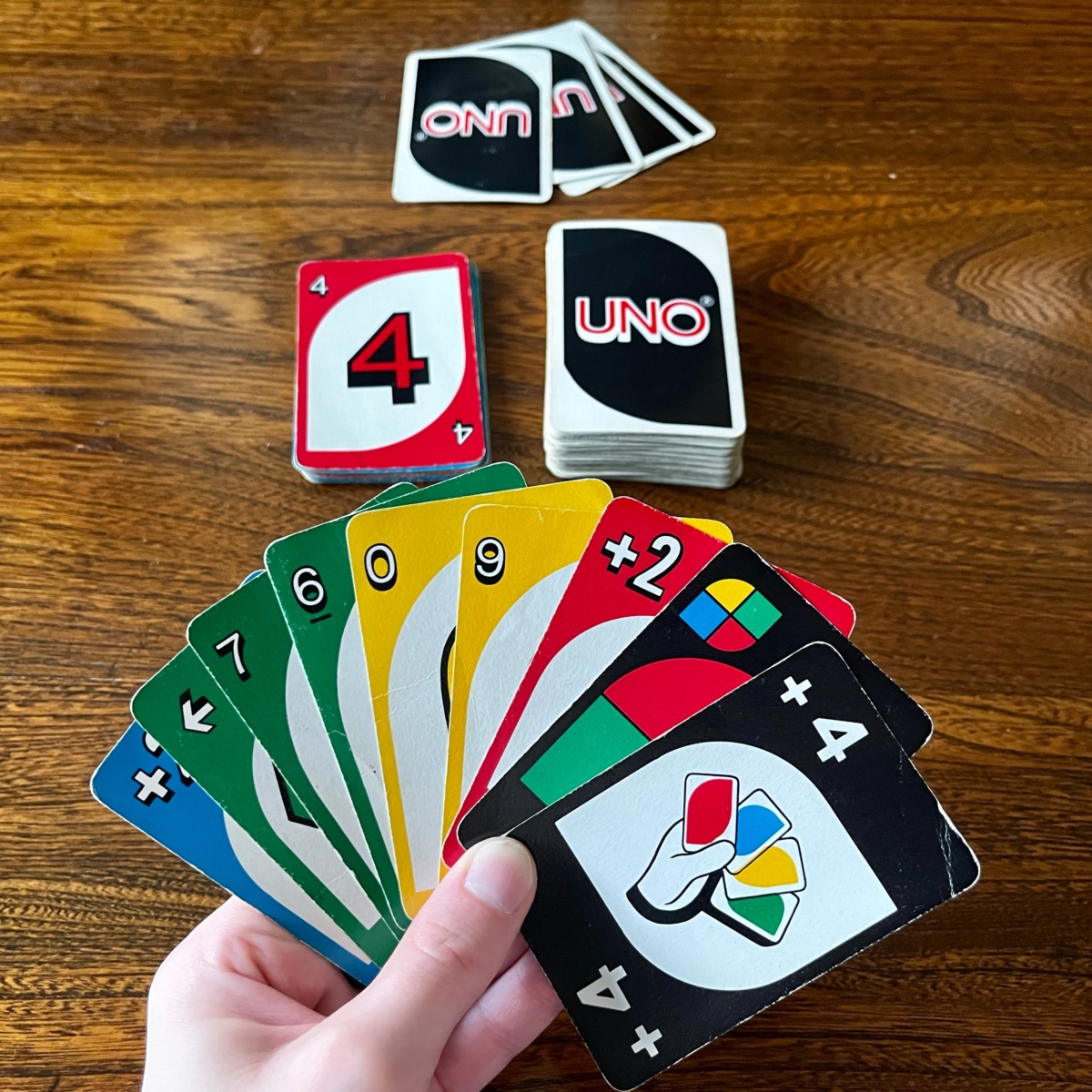
This player can play their red Draw Two or their Wild card. They may not play their Wild Draw Four card since they have a card that matches the current color (red).
If a player cannot legally play a card from their hand, they must draw a card from the draw pile. If this new card is playable, they may choose to play it immediately.
After a player has played a card — or drawn a card — their turn is over, and play continues with the next person in turn order. (This is initially the player to the left. However Reverse cards will change this direction during gameplay if you’re playing with more than 2 people.)
It’s important to remember that if a Draw Two or Wild Draw Four card is played, the next player’s turn is simply to draw that number of cards.
They lose the opportunity to play a card from their hand. Similarly, when a Skip card is played, the next player loses their turn entirely.
Going Out – “UNO!”
When a player has played the next-to-last card in their hand, they must announce “UNO” aloud for all players to hear.
If they don’t, before the next person plays, anyone can catch them and call the player out. The caught player incurs a penalty and must draw four cards.
When someone plays their last card, the round ends. (If the last card played was a Draw Two or Wild Draw Four, the next player still draws accordingly.) Then the other players count the points for the cards remaining in their hand.
The points for each card are as follows:
- Cards numbered 0 to 9: their face value (i.e., a 6 is six points).
- Draw Two, Reverse, Skip: 20 points each.
- Wild Card, Wild Draw Four: 50 points each.
The points are then awarded to the player who went out. If they have 500 points, they win. If not, a new round of play begins.
Common Misplayed Rules
If you’re like me, you’ve played a decent amount of Uno in your life, sometimes correctly following the rules above — but more often incorrectly using the house rules your friend’s sister’s cousin taught you that one time.
Here are some of the most misplayed Uno rules:
- Stacking. Play a Draw Two on another Draw Two, and the next person draws four cards, right? Wrong. Officially there is no stacking of any sort in Uno.
- Doubles and Triples. A sub-variant of Stacking. You only play one card on your turn. One.
- Draw Cards Until You Can Play. Whoever has tricked you with this fake rule just wanted to laugh at you as you tried to manage a hand of 25 unplayable cards.
- Wild Draw Four Any Time. Right up until I wrote this review, I didn’t know there was a restriction on when you could play a Wild Draw Four card. This will be a game-changer for sure.
Uno Review
Full disclosure: I can be a tad sentimental, so even though I’m deeply into the modern board gaming hobby, Uno still has a special place in my heart because of how often I used to play it with my family and friends who weren’t as obsessed with games as I was.
Sentimentality aside, Uno isn’t a particularly elegant or clever game.
It is, arguably, a more confrontational and vicious Crazy Eights-style of game that is incredibly lucky and has a shocking amount of finicky rules for a straightforward game.
(In my review, I didn’t even get into the team/partnership rules, reneging, the various penalties you can impose, and the “Challenge” variant that eliminates players and has them sit around spectating until a winner is determined.)
Moreover, like other games where house rules have taken over the official rule set (looking at you, Monopoly and Catan), games of Uno that begin as silly fun can turn nasty quite quickly because of the chaos that the commonly misplayed rules introduce.
The catch-22, though, is that a game of Uno isn’t as exciting or interesting without those ridiculous rules.
Final Thoughts
While I can appreciate its longevity in the board game industry and all the fond memories — good and bad — I have of playing it throughout my life, Uno will never be a game that I ask to play.
Furthermore, we are in a golden age of amazing board games, and there are games that are just as approachable and inexpensive as Uno, yet far more stimulating, that I would prefer.
You might also be interested in the following:

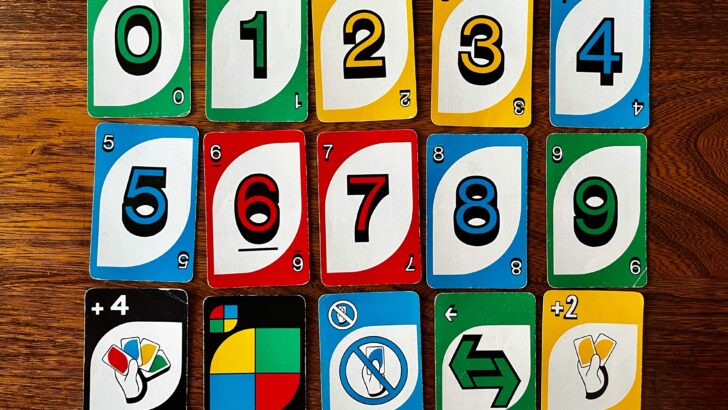
Sprawlopolis Review — Nobody Said City Planning Is Easy
Monday 4th of December 2023
[…] Uno Review […]
Red7 Review - All the Colors of the Rainbow
Monday 26th of June 2023
[…] Uno Review […]
Point Salad Review — You Don’t Make Friends With Salad
Tuesday 20th of December 2022
[…] Salad isn’t necessarily a directly confrontational game — like, say, Uno is — but you will find that players indirectly mess with your plans time and […]